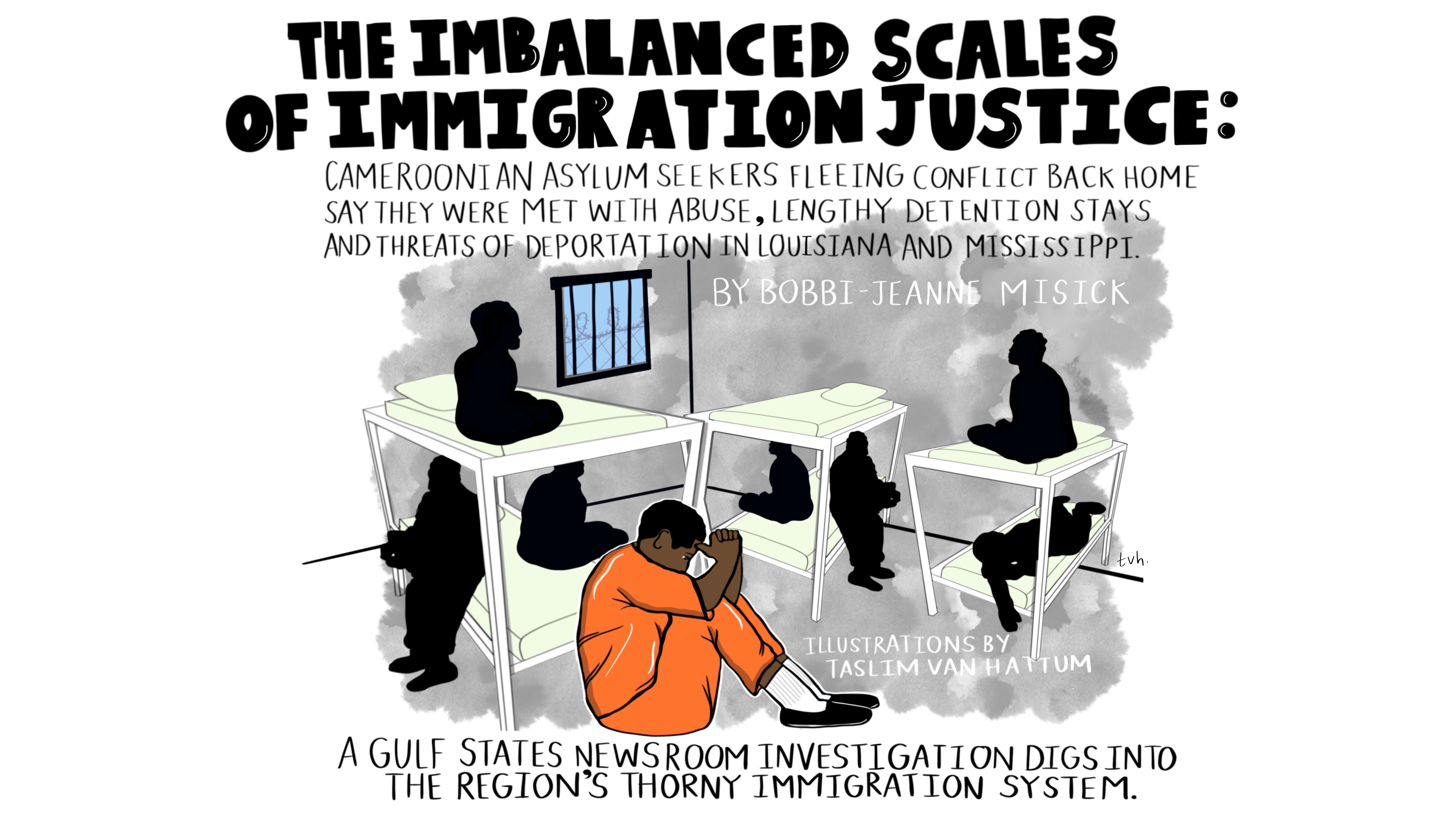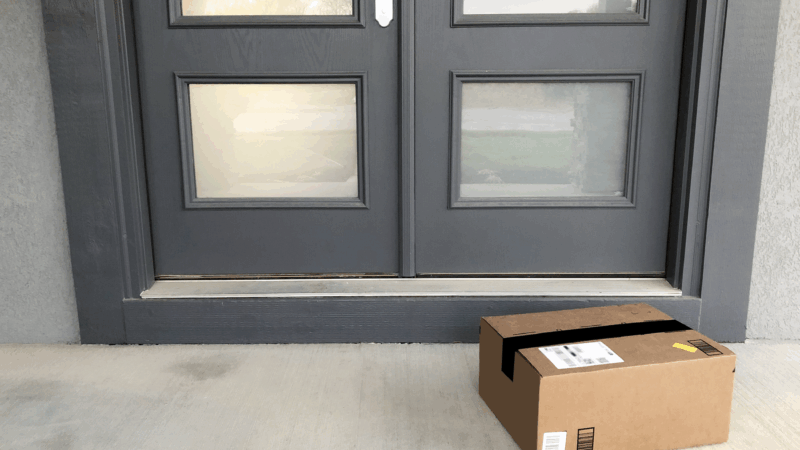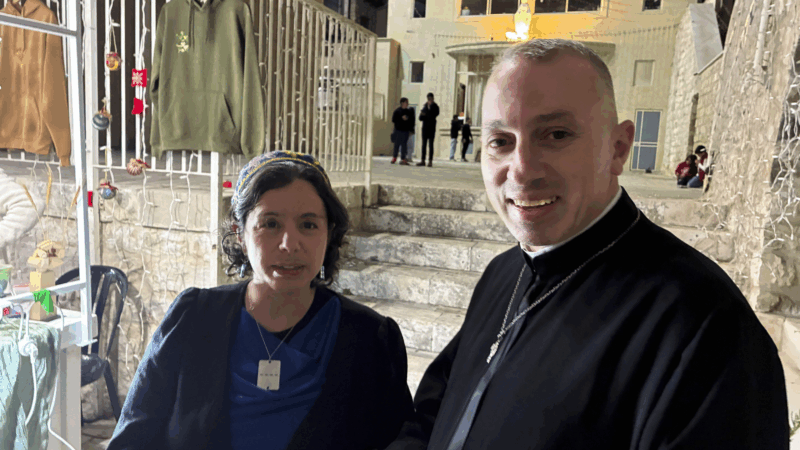Denial, detention and deportation threats: The uphill battle for Cameroonian asylum seekers in Louisiana and Mississippi
This story was produced in partnership with Type Investigations, where Bobbi-Jeanne Misick is an Ida B. Wells fellow.
BJ stared in disbelief at the box on the piece of paper. It had an X inside it. That X in that box sealed his fate in the United States. It meant he could not apply to safely remain in the U.S., even though, as he tells it, he was tortured and later hunted by military police officers in Cameroon and sought after by vigilante fighters.
He still bore the scar on his leg from when he says military police officers dragged him along the ground. He remembers the daily beatings he received in jail. He says officers beat him on the soles of his feet with a machete and threw water on the ground where he slept.
BJ is a pseudonym, used because he fears retaliation in the U.S. and against his family in Cameroon.
The X was on a worksheet BJ received after undergoing a credible fear interview — generally, the first step in the complex process to seek asylum or similar relief from persecution based on protected grounds, including race, gender and political opinion. In theory, the interview is a simple screening where an asylum officer determines whether an asylum seeker’s story seems plausible enough to consider sending their case to an immigration judge. But in reality, it has huge implications.
That X meant that BJ had received a negative credible fear determination, which barred him from even applying for relief. It would keep him stuck in deportation proceedings. He could be sent back to Cameroon, where he was certain he’d be detained indefinitely or killed. The X erased the hope he had to see his wife and children again.
A simple marking was the beginning of years of denial, detention and threats of deportation that would redefine his notion of survival. He’d unknowingly been sent to a region of the United States where immigrants languish in detention. His experience — and that of the other Cameroonians detained in Louisiana and Mississippi — reveal a thorny regional system with obstacles at every turn that, more often than not, keeps asylum seekers from realizing their dreams of freedom and safety.
BJ is one of thousands of Cameroonians who have flocked to the U.S. to seek asylum protection since 2017, when a brutal conflict between the government and armed separatists erupted. That unrest collided with the sharp expansion of detention centers in Louisiana during former President Donald Trump’s administration and a wave of new, conservative judges — creating a perfect storm. At least 200 Cameroonians were sent to Mississippi and Louisiana, part of the New Orleans Immigration and Customs Enforcement Field Office, and the two Gulf states became a hub for holding and processing immigrants.
Gulf States Newsroom and Type Investigations found that immigration judges in Louisiana rarely sided with asylum seekers between 2016 and 2021, when Cameroonians were seeking protection in the U.S. in large numbers and when detention capacity in the state ballooned. This created higher barriers to asylum for Cameroonians in Louisiana courts than those that existed for their counterparts who sought asylum in courts in other parts of the country. Asylum seekers were then incarcerated in detention centers where some say they were abused and punished when they protested their treatment or resisted deportation, according to complaints filed by human rights groups. The detainees were repeatedly denied release even as COVID-19 spread throughout the facilities. An analysis by Gulf States Newsroom and Type found that many Cameroonians were detained for at least one year and up to more than three years.
BJ arrived in the U.S. in late 2019. While in detention, he learned he could request a review of his credible fear decision from an immigration judge, and the judge could possibly annul his negative decision.
“The guys in the detention center said, ‘Oh don’t worry about that,” BJ recalled. “‘When you go in front of the judge, you can express yourself.’”
He could explain his story to an immigration judge, in person. The judge would listen to him and have the power to change the decision — to remove that X.
As BJ retells his experience with the immigration judge, his smooth black eyebrows raise above still bewildered soft dark eyes. He is 5 feet, 6 inches tall with a sturdy frame from years of carpentry work back in Cameroon, where he built furniture in his own woodshop. He gestures a lot with his hands and gently shakes his head when he talks.
On the day that he and several others were scheduled to have their cases reviewed, BJ was surprised to see that the judge was not there in person. Immigration Judge Brent Landis appeared on a screen. BJ said the group was sworn in all at once. Each had their moment to step into a room and make their case to Landis. One by one, BJ saw asylum seekers, most of whom he said were from Cameroon, return with tears in their eyes.
Then it was his turn.
As BJ recalled, Landis only asked his name, his date of birth and the date that he entered the U.S. With that, Landis affirmed the negative credible fear determination, sticking with the asylum officer’s original decision. BJ said he pleaded with Landis to allow him to explain his story, but he was told not to speak unless he’d been asked a question. Landis spun his chair around. It was over.
A representative from the Executive Office of Immigration Review, which oversees immigration courts, said “immigration judges do not give interviews on behalf of the agency.” The representative also said EOIR does not comment on immigration judges’ decisions.
After Landis made his decision, BJ received a final deportation notice. With a negative credible fear determination, he would almost certainly be sent back to his home country.
But while BJ was in detention, immigrants’ rights advocates were fighting for a legal path forward for him and other Cameroonians in danger of deportation.
Advocates had begun urging the Trump Administration and Congress to grant Cameroonians temporary protected status, which allows citizens of specific countries that are deemed unsafe to stay and work in the U.S. without fear of deportation for a specified length of time.
In April, the Biden administration announced it would grant Cameroonians TPS for 18 months, formally recognizing that the ongoing armed conflict and humanitarian crisis in Cameroon made it too dangerous for many to return home.
But as our analysis found, for years leading up to that victory, immigration judges and asylum officers in the Gulf South often did not acknowledge this danger. Most Cameroonians sent to the New Orleans ICE Field Office were denied asylum, detained in former private prisons, and many were deported.
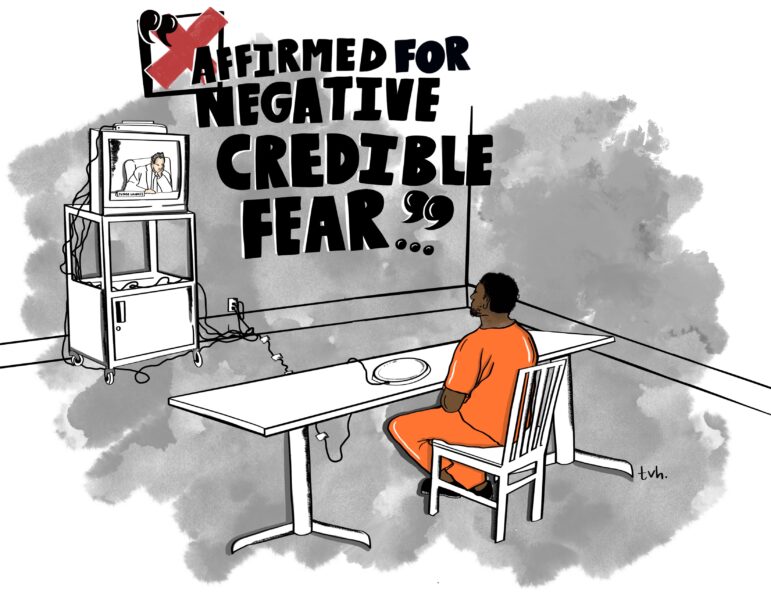
U.S. Immigration courts are tough. Louisiana’s are even tougher
Asylum seekers face stiff odds in most immigration courts in the U.S., but Louisiana immigration courts are among the harshest in the nation. Louisiana judges upheld a higher percentage of negative credible fear determinations than the country overall; nationwide, a vast majority of such determinations are upheld by judges. Over the last few years, thousands of immigrants in Louisiana were not able to even apply for asylum because of judges’ decisions.
With initial data assembly and interpretation provided by the Human Rights Center Investigations Lab at the University of California, Berkeley, Gulf States Newsroom and Type Investigations analyzed immigration courts’ asylum decisions between fiscal years 2018 and 2021. In that time period, Louisiana judges upheld 93.7% of all negative credible fear determinations that came before them in reviews. For Cameroonians, Louisiana judges agreed with nearly 90% of asylum officers’ negative decisions. Nationally, judges were more inclined to overturn negative credible fear determinations for Cameroonians, siding with the asylum officers’ negative decision roughly 32% of the time. A previous analysis by the students of the Human Rights Center Investigations Lab showed that immigration judges nationwide upheld more than 72% of all credible fear determinations they reviewed between October 2017 and August 2021.
Landis, the judge who ruled that BJ’s fears were not credible, upheld 99.4% of the negative determinations that came before him during that time — keeping the Xs in place for all but 2 out of 314 asylum seekers. Between fiscal years 2019 and 2021 Landis upheld all negative credible fear determinations that he reviewed.
The implications are critical. BJ remained in final deportation proceedings. He lived in detention for 17 months, he said, while his immigration attorneys made multiple requests for asylum officials to reconsider the original decision. During that time, BJ says he was physically attacked for refusing to sign his own deportation documents; and was selected for deportation and then spared at least twice.
BJ’s quest for safety
Cameroonians began arriving at the Mexico-U.S. border in large numbers after a brutal conflict erupted in 2016 in Cameroon’s formerly British Anglophone regions along Nigeria’s southeastern border. After decades of feeling marginalized by the Francophone central government, Anglophone Cameroonians began peacefully protesting. The Francophone government violently quashed the protests, which had been mostly led by lawyers and teachers. Secessionists then rose up and entered the battle against the government. Since then, Cameroonian government armed forces have burned villages and detained and even killed civilians. The armed separatists have committed abuses of their own.
This is what BJ was running from. He said he was targeted by both government and separatist forces. It began when secessionists kidnapped his sister on her commute from work at a local hospital and brought her to one of their hiding places. They thought she was a nurse and could care for their wounds, she later said in an affidavit, but she actually worked as a lab technician.
Frantic to find a way to get her back, BJ called someone from his neighborhood who’d joined the separatists and explained that his sister was of no use to them. He arranged for her release. When they were reunited, she had been blindfolded and tied at the ankles and wrists, but she was finally safe.
Relieved and thankful, BJ’s sister began spreading the word about her rescue. But soon after, she was visited by military officers demanding to know where the separatists were hiding. She told them she had been blindfolded and didn’t know their whereabouts and that her younger brother had rescued her. The officers, claiming they suspected him of being a separatist, arrested BJ inside his home and took him to a local jail.
Inside the jail, BJ said police officers used a machete to beat the soles of his feet. They demanded to know where the separatists were hiding.
Through tears, he gave them the phone number he’d called to secure his sister’s release. But later he overheard the officers saying they would transfer him to Kondengui prison in Yaounde, Cameroon’s capital. It’s a prison that international organizations have criticized for overcrowding and poor conditions.
When he heard this, BJ said he began to cry inside the jail cell.
“When they move someone from that place to Yaounde, it means you are not gonna come back,” he said.
On his fourth day in the jail, before he could be transferred, an officer, whom BJ calls “a good samaritan police,” helped him escape. He opened the cell door and let BJ run, but warned that the police would continue to come after him.
He ran away. When he got home that night, he packed a bag, left his wife and three children and fled to a suburban area in the Northwest. But BJ said police officers eventually came looking for him there, so he went South again.
BJ’s brother-in-law arranged for him to leave the country. BJ said he wasn’t planning to travel to the U.S. He just wanted to be somewhere where he felt safe. He eventually made his way to Ecuador, which did not have visa requirements for Cameroonians at the time. Without Spanish language skills, Ecuador felt impossible to integrate into. So, he kept going until he got to the Tijuana-California border and requested asylum in late 2019.
Because BJ did not have a visa or legal status in the U.S. when he entered the country, he was considered a “defensive” asylum seeker. Requesting asylum was his only defense against deportation. That meant he faced even steeper hurdles to stay in the country. In contrast, “affirmative” asylum seekers, who enter the U.S. on a visa or some other provision and then apply for asylum, face a much less adversarial process. If BJ had been an “affirmative” asylum seeker, he would have been able to build his case outside detention, making it easier to reach his lawyers and gather evidence for his case.
A confusing process and a high bar
After passing through screenings with U.S. Customs and Border Patrol, he was detained in California and later transferred to Mississippi, where he was interviewed for the credible fear screening — that first step in the asylum-seeking process.
No officials prepared him for it, he said. It took place in a room with a chair and a cell phone and not much else, BJ remembered. When the phone rang, he did his best to explain what he’d been through to the asylum officer on the other end of the line.
The English BJ speaks, called Cameroonian Pidgin English, is very different from the English of the asylum officer on the other end of the phone.
“There are things he asked me that I wouldn’t even understand,” BJ said.
When he said he didn’t understand, BJ said the officer would repeat the question in the same way. Eventually, he stopped trying to answer questions that he couldn’t decipher.
According to BJ’s attorney, Joseph Giardina, who got involved in his case after BJ had already received his order of removal, it seemed the Houston office was more concerned with small discrepancies than his overall persecution, which he had evidence to back up.
Minor things were flagged as evidence he was not credible, according to documents Giardina submitted to USCIS. For example, when the officer asked if he knew anyone else who was persecuted, BJ couldn’t recall the name of an acquaintance.
“Everyone would acknowledge that [Cameroon] is a country where these things do happen to people that are in exactly the same situation as he was,” Giardina said. “And to find him not credible based on a few perceived inconsistencies that were not even really inconsistencies is just not appropriate.”
What BJ went through is part of a troubling pattern called out by others in an official complaint filed in 2022 by immigrants’ rights attorneys and advocates submitted to the DHS Office of the Inspector General. It said the Houston Asylum Office, where the asylum officer who interviewed BJ was based, was applying a higher legal standard to credible fear interviews than is required at that stage, resulting in potentially more negative determinations in the areas the office services.
Even if BJ had received a positive credible fear determination, he would have been fighting a near-impossible battle to win asylum in Louisiana’s immigration courts. The state had the fourth highest asylum denial rate in the country at 88% between fiscal years 2016 and 2021, according to Gulf States Newsroom analysis of immigration court data sorted by the nonprofit Transactional Records Access Clearinghouse at Syracuse University.
Judge Landis, who reviewed BJ’s credible fear determination, denied asylum to more than 95% of the immigrants whose cases came before him between October 2018 and September 2021. Other judges in that court had similar or even higher denial rates.
Immigration attorneys in the region suggest the sky-high denial rates might be related to the fact that many immigration judges first rose through the ranks as lawyers for the Department of Homeland Security and ICE. Landis is a former ICE litigator. He had argued in favor of deporting immigrants as a senior attorney for the agency in Phoenix from 2000 until 2018 when he became a judge. He is far from an outlier. Most of the 14 immigration judges operating in Louisiana courts during the Trump administration previously worked in immigration litigation for the federal government. Six of them had been ICE attorneys.
“That’s a similar problem to criminal courts, where there’s been some recent improvements, but generally the bench is stacked with former prosecutors and so they’re just more inclined to believe that side of the case,” Mary Yanik, director of the Immigrants’ Rights Law Clinic at Tulane University, said. “If you’ve spent years trying to build cases to deport people, you’re looking for that evidence..”
‘They were not releasing people, so we were just there.’
Before BJ arrived at the U.S. border, U.S. Immigration and Customs Enforcement began acquiring contracts with local jails and private prisons in Louisiana. These facilities had been shuttered as Louisiana sought to reduce its incarcerated population, and amid reports of abuse and medical neglect in the prisons. Between October 2017 and July 2019, the number of immigration detention facilities in Louisiana grew from five to 12. Over the same time period, the number of immigrants detained in Louisiana more than tripled from 2,210 to 7,907, according to data analyzed by TRAC. As of November, Louisiana still had the second-largest population of ICE detainees in the country.
According to immigration attorneys, immigrants sent to the New Orleans ICE Field Office are typically sent to Mississippi detention centers for processing and then shuffled to one of the facilities in Louisiana.
BJ said he spent the bulk of his time in detention in Mississippi’s Adams County Correctional Center in Natchez, a city that runs along the river.
Adams was like the other facilities in the region — large rooms with rows of many beds. BJ got a job in the kitchen baking bread to pay for phone calls to his family, a wife, two daughters and a young son, in Cameroon and to pass the time.
But eventually, time stopped being relevant. When he talks about his detention, it’s hard for BJ to recall if days, weeks or months passed between events. Instead, he says “after some time.”
Sleeping was hard. It became nearly impossible when his wife told him that Cameroonian military police officers and separatists had been visiting and threatening her at home.
After that, he’d lay in bed without sleeping every night. He said he started hearing voices — someone calling his name.
He decided to spend more time in the kitchen. He would bake for hours on end, hoping to tire himself out and finally, exhausted, fall asleep.
Eventually, he settled into life at Adams County Correctional Center, doing his best to embrace it as home. He knew it was either detention or deportation.
“I preferred to stay at Adams, even for the rest of my life, because I know what will happen if I go back over there to Cameroon,” he said. “… I just decided this is my home, this is where I’m going to be … they were not releasing people. So we were just there.”
Habeas corpus — a last resort for release
Lots of immigrants were languishing in detention in the Gulf South during this time. Just there. And the door to parole — release from detention — was effectively shut. According to a lawsuit filed by the Southern Poverty Law Center and the ACLU of Louisiana Foundation, the New Orleans ICE Field Office denied 98% of all parole requests it received in 2018. The field office granted no paroles for the first eight months of 2019, according to SPLC, and a later report from ACLU found it denied 99% of parole requests for the rest of that year.
Even when the Field Office did grant parole, it was rarely to Cameroonians. An SPLC analysis of parole data from December 2019 to August 2020 found that Cameroonians were 2.5 times more likely to be denied parole than non-Black immigrants detained within the New Orleans ICE Field Office region.
With little to no chance of getting out, detainees spent months and in some cases years in former prisons, where some complained of moldy food, filthy surroundings and extended stays in solitary confinement, according to complaints submitted to DHS by immigrants’ rights organizations.
As a last resort, some filed for a writ of habeas corpus to argue for their release. Migrants who are detained longer than six months with no clear sign that they’ll be deported anytime in the near future can petition for the chance to appear before a federal judge, who can decide whether further detention is justified or constitutional.
To understand just how long Cameroonians were being detained, the Gulf States Newsroom and Type Investigations analyzed 217 habeas corpus petitions filed in the Western District of Louisiana federal courts, which handles almost all habeas cases for detainees in Louisiana, in 2020 and 2021. Seventeen percent, or 37, of which were from Cameroonians. The overwhelming majority of Cameroonian petitioners had been in immigration detention for more than a year before they filed. One man spent roughly 28 months behind bars and another more than three years.
The Supreme Court’s 2001 decision in Zadvydas v. Davis expressed constitutional concern with prolonged detention. In his majority opinion, Justice Stephen G. Breyer said after six months in detention, the government must start a case to determine whether continued detention is reasonable.
Petitioners likely stayed in detention for longer than six months. A study of habeas corpus petitions filed between January 1, 2010, and July 31, 2020, by the Tulane University Immigrants’ Rights Law Clinic found that immigrants seeking relief in the Western Louisiana federal court often waited an average of 13 months before even filing their petitions and then months longer before their release. Often, the study found, ICE releases them before a federal judge can rule on the legality of their detention, in what’s been called “shadow wins.” Their cases are dismissed, so judges do not have a chance to set a precedent for detention time limits. They’re released at ICE’s discretion and could be detained again at any time.
That’s how Fabrisk Bidpua, a Cameroonian student fleeing the conflict, was eventually released. By the time an immigration judge denied him asylum in April 2020, Bidpua had spent over seven months in detention, according to his habeas corpus petition.
He did not want to be deported, but he also did not want to remain in a place where “they treat immigrants worse than prisoners,” he said.
Despite the odds, Cameroonian detainees push back
Bidpua told GSN and Type that Black immigrants felt they were being treated differently than other detainees at Pine Prairie and felt their dorms were more crowded.
Sometimes they would be left in a dorm room without air conditioning for weeks, Bidpua said. With so many people sweating in one humid room, moisture would pool on the floor. Bidpua says he and his dorm mates would sop up the puddles around the room up to six times a day. Without air conditioning, the dorm quickly began to smell. He said officers stopped entering the room, saying the Africans smelled bad and had poor hygiene.
When the COVID-19 pandemic began, Bidpua felt the detention center wasn’t doing enough to keep the virus from spreading. He joined a class action habeas petition that argued detainees should be released because they were extremely vulnerable to COVID-19 and it was impossible for them to limit exposure in Pine Prairie.
In August 2020, Bidpua and nearly 50 other African detainees, mostly Cameroonians, staged a hunger strike at Pine Prairie — a continuation of a previous strike declared in March. They wanted to show solidarity with the Black Lives Matter protests happening all over the U.S. They were also fed up with what they saw as indefinite detention, racist treatment, poor conditions and sweeping parole denials, among other grievances.
The strike began on August 10, 2020. Protesters were allegedly met with threats of solitary confinement, use-of-force, including choke-holds, and pepper spray, according to a complaint that SPLC and other immigrants’ rights organizations filed with DHS’ inspector general and the Office of Civil Rights and Civil Liberties.
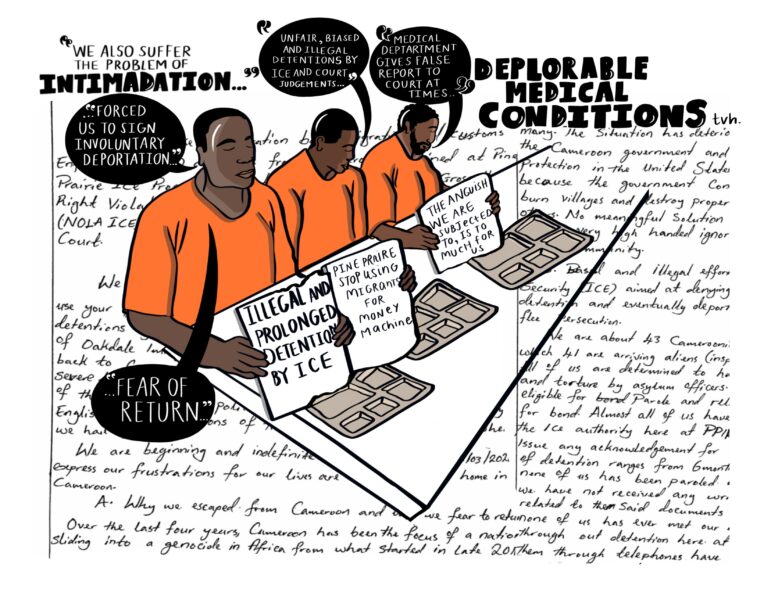
The group paused the protest at ICE’s request, but when negotiations failed, according to the complaint, the hunger strike resumed on August 21, 2020. Bidpua said the guards still made them go to the dining hall and separated them so only a few protesters were taken in each meal shift. When one shift of protesters tried to leave the dining hall without eating, according to a Human Rights Watch report, guards shoved three men to the ground and piled on top of them. When the men returned to the dorms, Bidpua said he saw bruises on their hands.
Soon after that protest resumed, according to the SPLC complaint, the 45 men on hunger strike were taken to solitary confinement — some for up to 15 days, Bidpua said.
The Office of Civil Rights and Civil Liberties, according to the HRW report, said they were “unable to substantiate the allegations raised” and closed out the investigation, though the complaint authors called the investigation “deficient” and said the protesters had never been interviewed. CRCL and OIG did not respond to questions about whether or not it is still investigating the other complaints alleging abuse and punitive treatment at Pine Prairie.
GEO Group, the company that operates Pine Prairie, denied the allegations in the complaint.
“We strongly reject these allegations, which we believe are being advanced by radical special interest groups with a politically-motivated agenda. We especially reject any allegations of discrimination on the basis of race or country of origin,” Christopher Fereira, a representative for Geo Group, wrote in an email. “Under no circumstances is assignment in a special management unit used in a retaliatory manner or without careful adherence to ICE’s Performance-Based National Detention Standards.”
After the hunger strike ended, Bidpua was one of many who received medical attention. Some were transferred to other facilities in Louisiana, but he remained in a waiting game – stuck in detention at Pine Prairie with slim chances of getting out, hoping his name would not be on the next list of Cameroonian deportees.
A renewed urgency — and alleged use of force — for deportation
For much of 2020, deportation was not a viable option, leaving Cameroonians stuck in detention. Cameroon, like many other countries around the world, closed its borders at the onset of the COVID-19 pandemic. But when the country began welcoming flights again, there seemed to be a renewed urgency to send them back.
BJ said he was assigned a new ICE officer every few weeks and every time the person would try to persuade him to sign or fingerprint his deportation document. He refused each time. He’d seen that people who didn’t sign these documents remained at the detention center and thought that was a way for him to stay. But the pressure ramped up.
On September 27, 2020, BJ said he was working his baking shift when an ICE officer came into the kitchen and demanded he fingerprint the deportation notice. When he refused, the officer said ICE would use force, he recalled.
“OK you better forcefully take it, because I’m not going to give it to you,” BJ remembered saying. He returned to work.
Minutes later, he was called to the medical unit, he said. When he arrived, he said, he saw other Cameroonians in the area. As he and other detainees would later write in a complaint to DHS’ Office of Civil Rights and Civil Liberties and Office of Inspector General, they were once again asked to sign or fingerprint their deportation paperwork. All of them refused.
According to BJ’s complaint, an ICE officer and detention staff continued to pressure them to sign the deportation paperwork. BJ said one member of the detention center staff issued a vague threat – “something would happen” if he did not sign.
BJ said the ICE officer called more facility guards to come help him “do the job.” After one more attempt at making BJ and the other detainees sign, the complaint alleges the guards left and returned in boots, knee pads and masks.
When they re-entered the room, BJ stood up from his chair. A cloud of pepper spray flooded his face. He could barely see. He fell over and hit his back on the chair. On the ground, he felt a guard grab him by the neck. BJ shouted that he couldn’t breathe.” He started crying. He felt his body getting weaker. Then he felt the clamp of handcuffs on his wrists and shackles around his ankles.
Then, he said, the guards transported BJ and two others to the isolation unit. They shoved them into a shower and turned on the cold water faucet. The icy water burned the skin around BJ’s eyes.
BJ remembers guards taking him to what he says was a nearly empty room with a bed but no mattress. He complained of chest pains and then vomited inside the cell. BJ said officers then grabbed his hand while he was still handcuffed, forced his fingers onto a paper and fingerprinted him. It was done. He could be sent back to Cameroon.
A representative from CoreCivic, Adams County Correctional Center’s parent company, denied the allegations in the complaint to DHS. Instead, he said, “On September 27, three of the detainees assaulted CoreCivic staff, and they were subdued. There were no injuries as a result, and no additional altercations.”
Adams wasn’t the only detention facility in the region accused of coercing people to obtain deportation fingerprints. Gulf States Newsroom and Type analyzed a set of complaints about facilities in the New Orleans ICE Field Office region and found that Cameroonians held at Winn Correctional Center and Jackson Parish Correctional Center, both in Louisiana, also alleged that they were violently forced to sign or fingerprint their deportation notices. In Pine Prairie, detainees described guards threatening to expose them to COVID-19 if they did not accept deportation.
LaSalle Corrections, Winn’s parent company, did not respond to requests for comment. In an email, Ferreira, the representative from Geo Group, called the allegations of coercion at Pine Prairie “blatantly outrageous and completely baseless.”
ICE declined to comment on the allegations of coerced fingerprinting in any of these facilities.
“U.S. Immigration and Customs Enforcement (ICE) is committed to ensuring that all those in its custody reside in a safe, secure, and humane environment under appropriate conditions of confinement,” an ICE spokesperson wrote in an email. “Furthermore, the agency takes allegations of misconduct very seriously — personnel are held to the highest standards of professional and ethical behavior. All allegations of abuse or other misconduct are taken seriously and are investigated. If any such allegations are substantiated, appropriate action is taken.”
TPS, and a new life in limbo
After the fingerprinting incident, BJ was transferred to Prairieland Detention Center in Alvarado, Texas ahead of a deportation flight to Cameroon and the Democratic Republic of Congo. There, he met immigrants’ rights advocates who documented his and others’ claims of abuse and filed a complaint to the DHS OIG and CRCL. He told them that he still suffered from chest pains that he attributed to coughing from the pepper spray. He said his eyes continued to hurt. Even now, two years later, he complains that he can no longer read for hours, one of his favorite ways to pass time while in detention. He says after 30 minutes his eyes begin to hurt and his vision blurs.
The attorneys who filed the complaint said that they never received a formal report or resolution from OIG or CRCL, and the agencies did not respond to questions from GSN and Type about the investigations. But news of the complaint mobilized Democratic representatives Bennie Thompson, of Mississippi, and Karen Bass, of California, to urge the Trump Administration to postpone any deportation flights to Cameroon until an investigation was completed. Lawyers for some of the Cameroonians fighting against deportation also raised concerns about the danger they faced if they were sent back. They said their clients were being sent on “death planes,” pointing out that the Cameroonian government was known for unauthorized killings.
But on October 13, 2020, the flight took off anyway.
BJ isn’t sure why he was spared from that flight. He is convinced that he would be dead or suffering in a Cameroonian prison if he had been deported.
This was all happening at a time when immigration policy in the U.S. was in flux.
During his presidency, Trump ended temporary protected status for Haitians, El Salvadorians and other people who’d been benefitting from the protection long-term. But as President Joe Biden took office, activists ramped up their efforts to secure TPS for Cameroonians. At the urging of immigrants’ rights advocates and politicians, ICE canceled a flight in February 2021 that would have deported about 60 Cameroonians, leaving from Alexandria, Louisiana, according to news reports at the time.
Shortly after Biden took office, he prioritized releasing people who did not pose a threat to public safety. BJ and Bidpua were eventually released while awaiting deportation. Bidpua went to Maryland to live with an aunt and uncle in an area with the largest Cameroonian-American community in the U.S.
BJ relocated to Houston and met other Cameroonians who had experienced a similar journey to the U.S. as him.
Living in detention for so long, he hadn’t been able to see the faces of his family in nearly two years.
BJ remembered talking to his family on a video call for the first time.
“That was so amazing for me,” he said.
His wife showed the boy BJ’s face and told him, “that’s your daddy.” When BJ left Cameroon, he was only three months old.
In Houston, uncertainty followed BJ. He and many others were released at ICE’s discretion. He worried that he could be picked up and detained again. BJ longed to be working for himself again, building furniture as he did in his workshop in Cameroon. While he waited for his work permit, he depended on the kindness of his uncle, who had accepted responsibility for him as a sponsor. But he couldn’t be fully comfortable.
“Think about it, someone like me sitting home, struggling to eat food, someone is giving me money to go eat food,” BJ said, worried about how long that support could last. “My family is back home. I need to put food on their table. … I need to pay the house rent. I need to pay the bills. My kids are in school. I need to pay the school fee. It’s so frustrating.”
BJ finally got a work permit last spring. He’s doing carpentry work, mainly building bar and dining spaces for Cameroonian business owners in his area. He printed business cards. When he talks about the work he’s doing, crafting banquets or a stage inside an events hall, his voice fills with pride. “I built all these things,” he’ll say.
He knew the work permit wouldn’t be enough. After escaping jail in Cameroon, making a dangerous journey to the U.S., spending nearly a year and a half locked behind bars, and barely evading deportation, true safety was still out of reach. His life was still in limbo. He could be picked up and detained again, or even deported — unless he received temporary protected status.
By then, it had been nearly three years since he said goodbye to his family. He had been hoping for something better ever since. Hoping to survive the journey from Ecuador through Central America. Hoping for his number to be called at the Mexico-U.S. border. Hoping for an asylum officer or a judge in the immigration system to believe him. Hoping his wife and children would be safe while he was locked up. Hoping he wouldn’t be deported.
There were more rounds of hope, followed by disappointment. In Washington, advocates and lawmakers continued to push for TPS. A bill was introduced in Congress, but it failed.
But on April 15, the day he and the roughly 40,000 Cameroonians living in the U.S. without protection had been waiting for, finally came. Alejandro Mayorkas, Secretary of Homeland Security, designated Cameroon for TPS for 18 months. It happened against the backdrop of the conflict in Ukraine and the swift granting of TPS for those nationals.
That morning, he checked his phone and his immigration group chat was overflowing with messages. He let out a joyful scream.
He called a friend, another Cameroonian who had lived with him in detention.
“We could not talk anything,” BJ laughed, “because we were just shouting!”
For him and so many others, TPS justified what they’d been telling immigration officials for years – that their lives were at risk if they returned to Cameroon and that they needed protection.
“No one will ever think of traveling from Africa, coming to America just to have a good life,” he said. “Just know that he is running away from something, and they need to protect the person.”
Still, he thought about those left behind. Only Cameroonians who were already in the U.S. are protected by the new designation.
Most nights, BJ sits at the bar of his favorite Cameroonian restaurant in West Houston and scrolls through images sent on a WhatsApp group of the carnage back home. He searches the images of dead bodies for familiar faces, hoping his wife and kids and extended family have not been killed. Pools of deep red blood collect atop rust-colored earth and surround civilians, some as young as his son, laying lifeless in the road.
He yearns for the days in Cameroon before the conflict. He thinks back to his childhood in the suburban village, where he felt free.
“The life was so, so smooth,” he said.
Now, his son knows to lie on the ground at the sound of a gun. The sight of dead bodies in the streets has become commonplace.
BJ doesn’t think he’ll ever go back to Cameroon.
He’s holding out hope that during the 18 months he has TPS, there will be some way he can win asylum. But his attorney says it’s likely out of reach.
He talks to his family every day. BJ is proud that even though he left home when his youngest was just a baby, he still calls him “daddy.”
His son only knows him through the phone, but his presence is palpable. When he’s upset, he tells his mother, “Call daddy! I need to report something to him.” If he has an argument with a playmate he says, “Wait til my daddy comes.” And when he talks to BJ on the phone he says, “Daddy, when are you coming to take me?”
BJ doesn’t have an answer for that, but he still hopes to reunite safely with his family.
After surviving years of denial, detention and threats of deportation, he has one focus: “I want to play my role as a dad … Then, I’ll be extremely happy.”
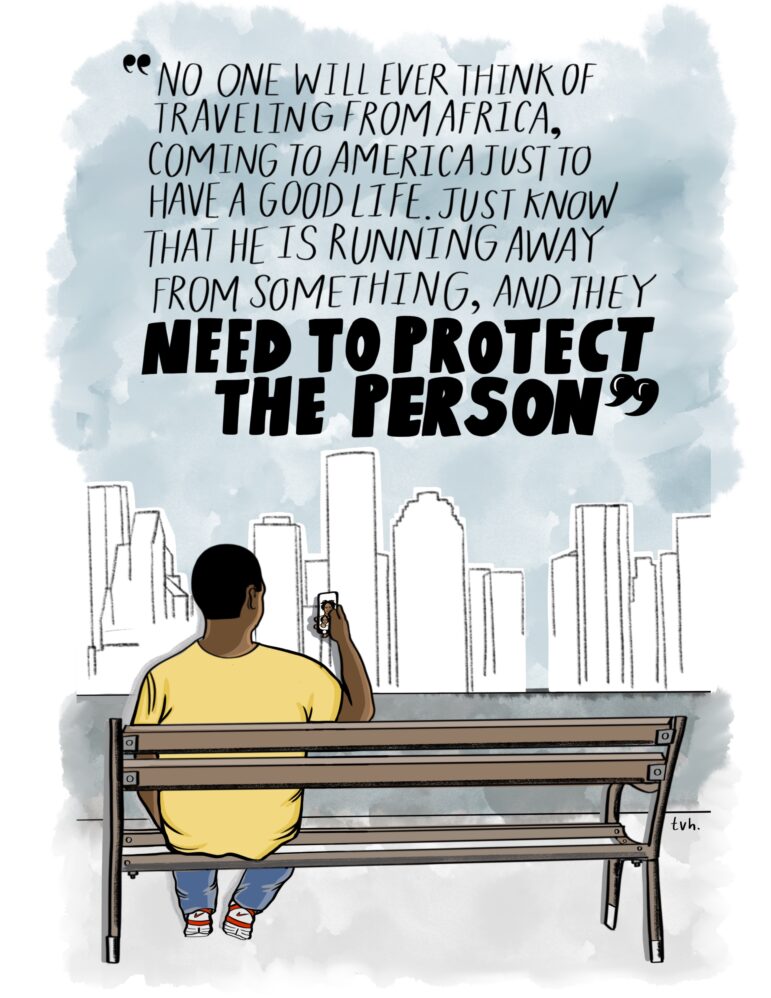
Research assistance on habeas corpus petitions provided by Paco Alvarez; Data analysis of Louisiana immigration judges’ credible fear reviews by Rashah McChesney and Stephan Bisaha; Data assistance and guidance for credible fear review analysis by the student team at the Human Rights Center Investigations Lab at UC Berkeley: team leads Catherine Vera and Vyoma Raman, members Aayush Patel, Aliyah Behimino, Carolyn Wang, CJ Manna, Ellie Wong, Karina Cortes Garcia, Maggie Carroll, Rosie Foulds, Upasana Dilip, Elena Wüllhorst, Aarushi Karandikar, Helia Sadeghi, and project advisers Dr. Alexa Koenig, Stephanie Croft, and Sofia Kooner.
This story was produced by the Gulf States Newsroom — a collaboration among Mississippi Public Broadcasting, WBHM in Alabama and WWNO and WRKF in Louisiana and NPR — in partnership with Type Investigations, where Bobbi-Jeanne Misick is an Ida B. Wells fellow.
30 years ago, ‘Waiting to Exhale’ was the blockbuster Hollywood didn’t anticipate
The 1995 adaptation of Terry McMillan's novel celebrated the beauty of Black sisterhood.
When porch pirates steal medicine instead of holiday gifts
Mail theft can happen around the holidays, but sometimes, instead of getting a new iPad, the thief swipes a mail order medicine. Here's what to do about it.
Timothée Chalamet, a Neil Diamond tribute band and more in theaters for Christmas
Also in theaters this week, Jack Black and Paul Rudd star in a meta reimagining of Anaconda, Amanda Seyfried in a Shaker origin story, and Ralph Fiennes plays a World War I-era choirmaster.
In the snow, these salamanders get supercool
Blue spotted salamanders have been seen walking across snow and new research suggests how they get by in the cold.
U.S. and Ukraine reach consensus on key issues aimed at ending the war
The United States and Ukraine have reached a consensus on several critical issues, but sensitive issues around territorial control in Ukraine's eastern industrial heartland remain unresolved.
Despite Vatican-Israel tensions, Catholics and Jews work to build trust in Haifa
Religious leaders started getting together after Oct. 7, 2023, in the hope of preventing a repeat of Arab-Jewish violence that erupted after a previous conflict in Gaza two years earlier.

